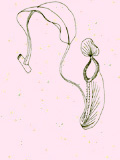
 |
Vertebrates (pdf)
|
Enormous fishing pressure on the whale sharks Rhincodon typus in Taiwan and southern China waters |
|
|
First sighting of the pearlscale butterflyfish in eastern Hong Kong waters |
|
Some insights from Taiwanese fisheries (pdf)
by Kenny Leung
I was very glad to attend a training workshop on "Modern Fisheries, Aquaculture and Seafood Processing" at National Taiwan Ocean University (NTOU) in Taiwan during early July 2005. It was co-organised by the Joint Committee of Hong Kong Fisher’s Association and the Agriculture, Fisheries and Conservation Department of Hong Kong SAR. During the workshop, we attended 3 days of intensive lectures at NTOU located in Keelung and then spent 3 days visiting different fisheries organisations and ports, aquaculture facilities as well as seafood processing plants in Taiwan. We travelled from the north to south of Taiwan, passing through Taipei, Suao, Hualian, Kaohsiung etc. Here, I would like to share some of my experiences and photos taken from this trip with readers of Porcupine!
In total, there are 300,000 fishermen in Taiwan and at least 1,000 vessels over 100 tonnes. According to the President of Overseas Fisheries Development Council of The Republic of China, Mr. Peter Ho, fisheries production contributed NT $ 97 billion or 0.54% of GDP in Taiwan in 2003 (equivalent to 1.5 million metric tonnes). Obviously, the scale of Taiwanese fisheries is many times greater than that in Hong Kong. However, like Hong Kong and other parts of the world, Taiwan is also facing problems associated with a significant drop in available fisheries resources, especially in coastal and offshore areas. Many traditional coastal fishermen cannot make ends meet and some can no longer fish. To resolve these problems, since 1980s the Government and fisheries organisations have been making huge efforts to transform the entire fishery industry. The components of such transformations include the development of distant water fisheries, establishment of eco-tourism (e.g. dolphin and whale watch, diving), deployment of artificial reefs for both conservation and eco-tourism (i.e. diving business), enhancement of aquaculture yield and improvement of marketing seafood products as well as implementation of fishing moratorium incentive schemes (Fig. 1). Based on my observations, Taiwanese fishermen are very united and well organised, and many of them are well educated, i.e. university graduates. These transformations create many job opportunities and improve the living standards of people within the fishery community. But it is not clear whether the fisheries are improving.
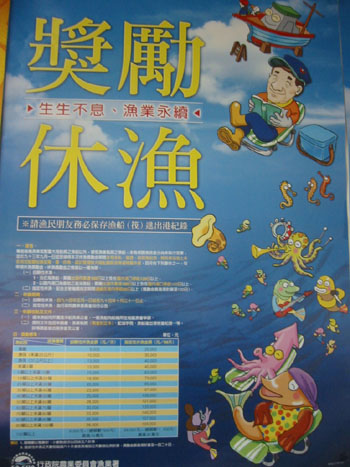 |
| Fig 1. An official poster announcing the fishing moratorium incentive schemes. |
There are two schemes:
Voluntary no-fishing – active coastal and offshore vessels must stop fishing and park at the port for at least 120 and 100 days, respectively. The period of ‘no fishing’ can be freely selected between 1 May and 31 October each year.
Official moratorium – all vessels must follow the suggested period given by the fisheries organisation and park their vessels at the port for at least 60 days.
Taiwan has been heavily subsidising the fishery industries. Due to the significant decline in coastal and offshore fisheries, the government has been promoting and helping the development of distant water fishing. So far, there are 30 advanced vessels in Taiwan (like the one shown in Fig. 2) which can be operated in deep-waters for catching high value fish such as tunas. Each of these vessels costs three billion NT dollars (= HK $0.7 billion); fishermen can’t afford this without the support from the government and private investors. In 2003, distant water fisheries contributed 58.5% of total fisheries production in Taiwan, whereas coastal fisheries only accounted for 4.2%. Nonetheless, I am concerned that many tunas, swordfish, sharks, tooth (or oily) fish, moonfish and sunfish have already been seriously over-exploited by such powerful fishing vessels. As I believe that pictures can speak better themselves, I have selected some photos (Fig. 3-11) to show some of these species (I must confess that I am not a good photographer). Although Taiwanese fishermen must follow the international quota system, the FAO Code of Conduct for Responsible Fishing [1] and international plans of action, the current trend of increasing effort in distant water fisheries will certainly do more harm to such fragile ocean ecosystems because many of these oceanic species grow slowly, reach sexual maturity at old age and have low reproduction rates. From discussions with fishermen and lecturers at NTOU and from the catch data, it is clear that even with increasing fishing effort, the yield of some key species such as blue-fin tuna Thunnus thynnus, and albacore tuna T. alalunga have declined substantially and fishermen have switched to catch more bigeye tuna T. obesus and yellow-fin tuna T. albacares which will be eventually depleted as well. We do need to ask what is the sustainable harvest rate or yield in the ocean?
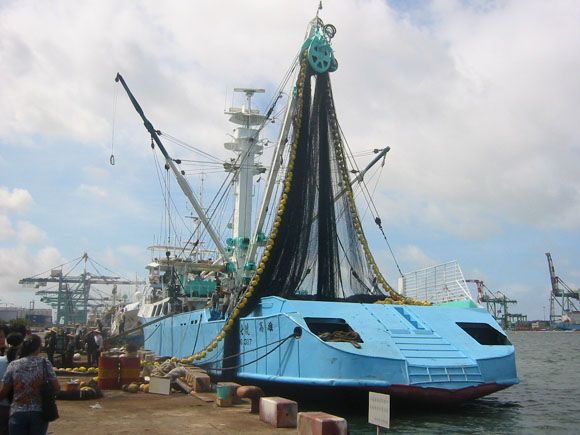 |
|
Fig. 2. Example of an advanced fishing vessel used for distant water fisheries with a 1.2 km long purse seine that can cover an area of 400 m2. It is equipped with a helicopter that can facilitate searching for tuna, and with a deep freezer to preserve the tuna at < -60° C. |
Different sizes of vessels will be awarded with different amounts of money from the Government to compensate their loss during the moratorium. For example, vessels of 60-70 tonnes will be paid NT $30,000 for option (1) or NT $ 133,000 per 60 days for option (2). The schemes are incentive-driven and very flexible when compared with the one in P.R. China.
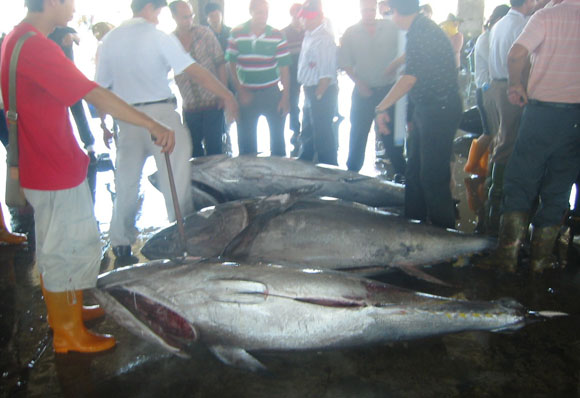 |
|
Fig. 3. Price negotiation between fishermen and buyers on the blue-fin tunas Thunnus thynnus. This was an exciting event in the port with many people watching and engaging in the negotiation. |
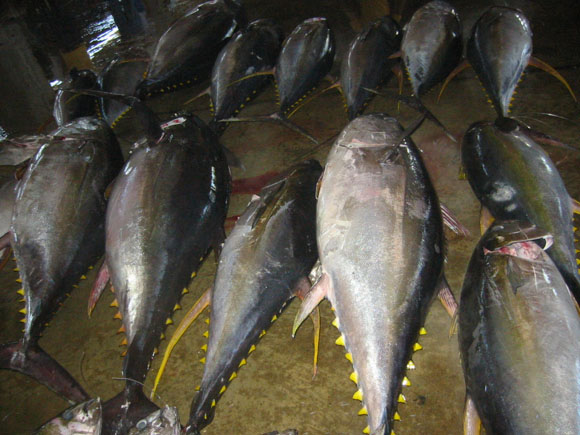 |
|
Fig. 4. Tens of yellow-fin tunas Thunnus albacares were displayed awaiting deals between the seller and buyer. |
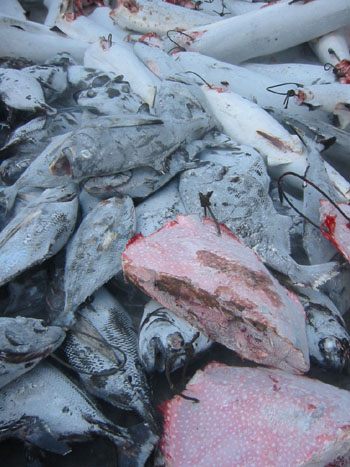 |
|
Fig. 5. Vessels using long-lines or long purse seines often catch many different fish species including sunfish, moonfish and many different shark species. |
Let’s talk about the bright side. I was delighted to see that some fisheries organisations have incorporated ‘green education’ in their eco-tours. During our visit, the word ‘sustainability’ has been mentioned many times by the presidents, directors, managers and fishermen in various fishery organisations, indicating that they do understand that marine resources are limited, and will be seriously depleted without proper management and enforcement. At least, it sounds optimistic and environmentally friendly. I hope they will achieve ‘sustainable fisheries’ through practice.
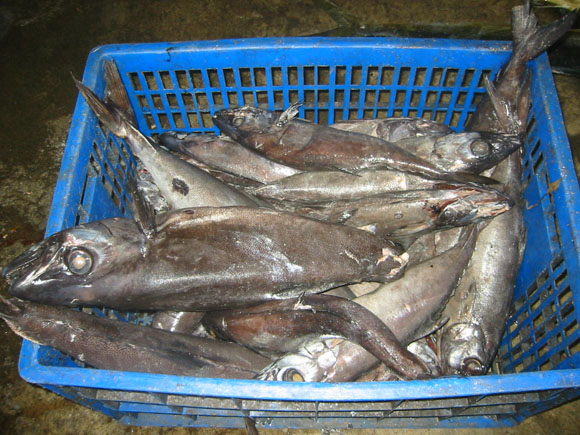 |
|
Fig. 6. Toothfish (or oily fish), Dissostichus species are also common in the offshore and distant water catches of Taiwanese fishermen. |
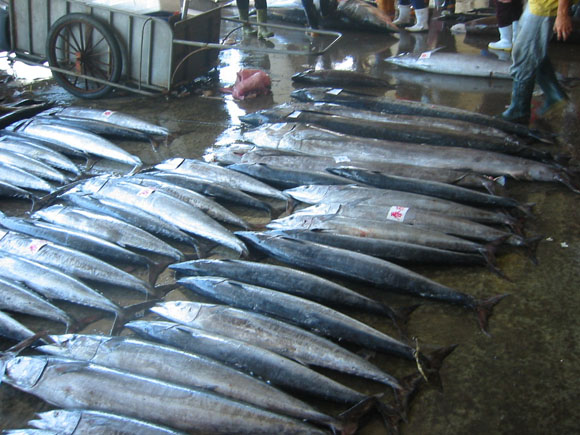 |
|
Fig. 7. Hundreds of various sizes of swordfish with their sword removed. Many of them were over two meters in length. |
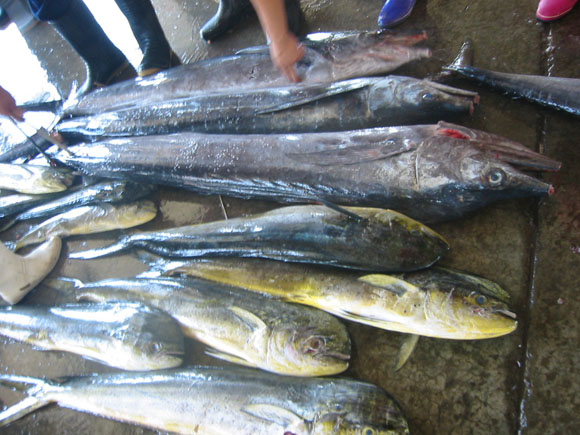 |
|
Fig. 8. Dorado fish, Coryphaena hippurus, are commonly caught by vessels using long-lines. |
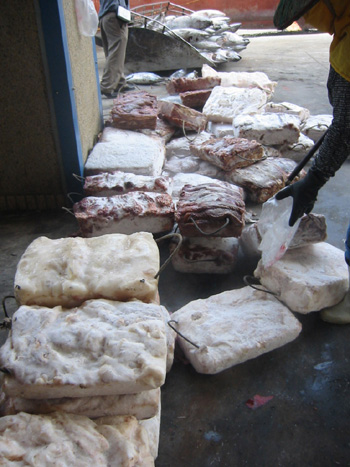 |
|
Fig. 9. Many fishes, such as sharks and sunfish, are dissected onboard and their muscle and internal organs separately frozen. The same method can be used to process whale sharks to evade the quota monitoring system. |
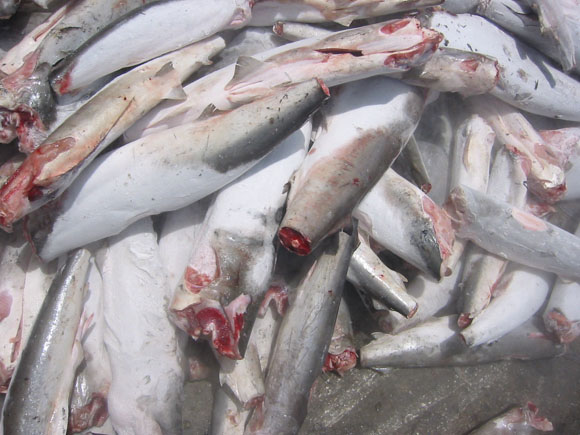 |
|
Fig. 10. Taiwanese fishermen argue that they never conduct ‘finning practices’ on sharks and that Taiwanese use every single part of the shark for consumption. They also believe that many shark stocks are still very healthy and that no quota should be implemented for sharks. But, as you can see this picture, just a tip of an iceberg, thousands of sharks are killed everyday. |
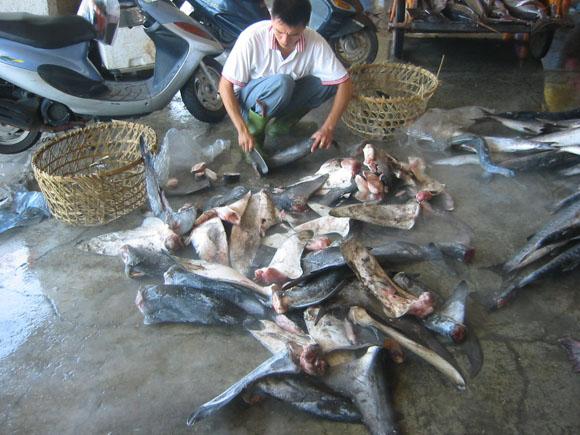 |
|
Fig. 11. Every single bit of the shark fin is removed and processed immediately after landing. There is a huge demand for shark fins regardless of the shark species, or their size, throughout SE Asia. |
Bibiography
[1] http://www.fao.org/fi/agreem/codecond/ficonde.asp
[2] http://www.afcd.gov.hk/fisheries/eng/capture.htm
Epilogue: on the one hand, ecologists and conservationists would like to see reduction in fishing efforts, and stock recovery; on the other, governments have to consider the social side and living conditions of fishermen by allowing and facilitating them to fish more. It seems a true dilemma in fisheries management. As we all know, the fishery industry in Hong Kong is somewhat getting close to its ‘sunset’. In 2004, there were only 9,500 fishermen (0.14% of 6.7 million of people) in Hong Kong [2]. In my opinion, our fishermen are less united and not as well-organised as Taiwanese fishermen; hence any transformation of the industry is rather difficult. Although our Government has been supporting and subsidising the fishermen for many years, our fishery development is still far behind counterparts like Taiwan. In Hong Kong, it is a bit late to develop distant water fisheries. So far, there is only one company directly engaged in distant water fishing. Building advanced vessels will require a large amount of money (@ billions $) while the operators must be well-educated in both ocean science and engineering. Probably, it is not a viable option for the traditional fishermen in Hong Kong. What is the way forward for our fishermen? This is an important but a difficult question for the Government, fishermen, politicians and academics. The Taiwanese model may offer us some useful insights.
| P.7-10 |
|
Porcupine! |
 Copyright © 2000 |
